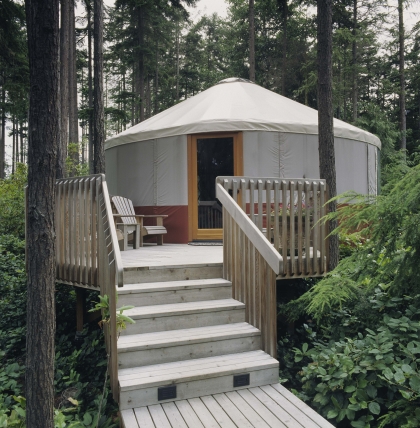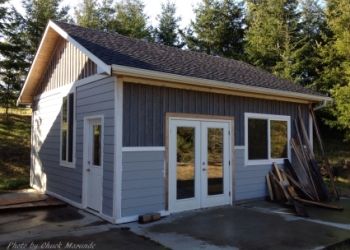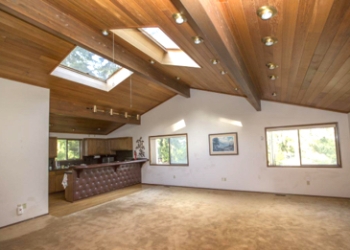I write about real estate on this blog, but it’s time for a little diversion. Today we have some fun looking at something that is still real estate, but not your traditional home. I wrote the following article for Pacific Northwest Home magazine, and it was published a little over a year ago.
What is the latest popular trend? I’m not asking what the latest technology fad is or what gimmick Steve Jobs is marketing. Forgetting about technology, gadgetry, and the Internet for a few minutes, what is one of the most popular trends around the country? If you can leave your email alone and stop surfing the Internet for 10 minutes, you might be surprised as we travel to ancient times in order to come back to the present. Yurts! You read that right. It’s not a typo. What you ask is a yurt? You might think of a yurt as a tent on steroids. It’s much more than a tent, but it is not a stick built home either. The yurt is an inexpensive, easily assembled dwelling that can be temporary or permanent. It can be a humble abode for overnight stays or summer vacations, or it could be a larger home with kitchen cabinets, a dishwasher and all the comforts of home.
Where did yurts come from? The yurt is the traditional dwelling of the nomadic people of Central Asia. They are found from Anatolia to Mongolia. Some think the Turks invented the yurt. There are bits of history referencing what were probably yurts dating back to the sixth century, and perhaps long before that. By the time of Marco Polo, yurts were widely used. It’s not possible to say which of the ancient nomadic tribes originally developed the traditional design, but the yurt is still in use by people throughout Asia and plays an important role in the lifestyle of the shepherd. To this day yurts remain one of the strongest, most efficient outdoor living structures ever devised.
Yurts are framed in a round design and are traditionally covered with felt or canvas. Today, these circular tents are becoming popular substitutes for cabins in many state parks, from Washington state to Rhode Island. Yurts are also popular in remote or harsh environments. They make great vacation homes, ski cottages, or hiking getaways. Some even use yurts as an inexpensive guest house, home office, spa enclosure, or an art or music studio. While stick built homes must comply with the International Residential Building Code, any dwelling, whether temporary or permanent must comply with county or city zoning codes and building requirements. The yurt is manufactured by a number of companies around the country, and there are models that are in full compliance with the International Residential Building Code.
Yurts typically arrive as do-it-yourself kits, and prices vary from less than $3,000 to $10,000 plus, depending on your options. You simply follow the instructions to assemble it, and with a little help from friends, you can assemble a kit in a couple of days. The engineering of a yurt creates a very strong structure. As the rafters push down and out, the tension cable circling the top of the lattice wall resists those forces, creating an extremely strong and stable structure. As a result, the circular shape makes them aerodynamic and able to withstand strong winds. Some manufacturers have a locking system that secures the rafters to the compression ring and to the tension cable with steel pins for added safety and wind resistance.
“The way the yurts are set up is beautiful,” said Kim Evans of Arlington, who spent a February weekend with her husband in a yurt at Grayland Beach State Park on the Washington coast. “You’re as close to the ocean as you can get at the park — it’s just beyond the dunes. Yurts have high ceilings so you don’t feel like you’re in a cave, lots of natural light from the dome skylight and they heat up quickly. We’re big fans of yurts in general and would plan a trip going from yurt-to-yurt if we could, rather than staying in hotels.”
“You can still have a campfire and a picnic and act like you’re camping,” said Scott Haley of Olympia, a devoted tent camper who, with the birth of his son, has become a fan of yurt and cabin camping. “With a young one it’s a big advantage. It’s comfortable and convenient — like a hotel room, more or less.”
State parks currently rent 38 yurts and 35 cabins in 11 parks across the state, with the most recent additions being yurts at Seaquest State Park, near Mount St. Helens, and cabins at Kitsap Memorial State Park on Hood Canal. State parks slated for new or additional units over the next two years include Ike Kinswa, Grayland Beach, Paradise Point, Deception Pass, Fort Flagler, Wallace Falls, Kanaskat-Palmer and Lincoln Rock.
Other parks are following this trend, including Snohomish County Parks with 15 yurts and cabins at two sites, Kayak Point Park and Flowing Lake Park, and an additional six yurts being built in River Meadows Park this summer. At 10 campgrounds around Washington, KOA Campgrounds rent their cozy camping equivalent: one and two room “kamping kabins” in Skagit County, Ilwaco and Leavenworth.
These camping options also encourage intergenerational outings, according to Ed Johanson, assistant manager at Kitsap Memorial State Park, where four new cabins were christened last May. “Some people rent a cabin for grandma and grandpa to stay in, then set up a tent or plug in an RV across from them,” he said. “With the cabins we’re able to offer experiences for different kinds of tastes so nobody’s excluded.”
Johanson calls it “convenience camping.” Cabin visitors benefit from the mid-sized refrigerator and microwave, but enjoy traditional campfire cooking outside on the grill. Others bring along crock pots, hibachis or propane stoves and, despite the romance of cowboy coffee, most appreciate electricity when it comes to their morning cup of joe. The yurts and cabins have individual picnic tables and fire rings.
“You’re in the middle of nature in considerable comfort. And in the wintertime a lot of people like to enjoy the parks when they are very quiet,” said Susan Mayer, marketing manager for Washington State Parks, who vacations in park rentals when she can. “With camping you have to take a lot of stuff with you and you’re open to the elements. In the yurts and cabins you’re part of nature in a very easy and very inexpensive way.”
Have you slept in a yurt yet? You haven’t lived until you do. Camping is a great way to spend time together as a family. If you want to find the nearest available state park and make a reservation, just Google “Washington State Parks yurts.” Once you’ve experienced a yurt, you’ll not only feel like you connected with the nomadic tribes of Central Asia, you’ll have a great ice breaker for those boring socials your spouse drags you to.
Last Updated on August 2, 2022 by Chuck Marunde































This “yurt” is very interesting concept. It does look nice and really looks like it goes very well in nature environment. Thanks for the information.
I`ve read couple of articles here and could say it was really interesting, thanks for sharing that. keep it up and good work
Nice pictures there. I really enjoy reading your post.
Very nice post thanks. I’ve featured your blog for my readers. The love your articles. Keep writing interesting insights into real estate issues.